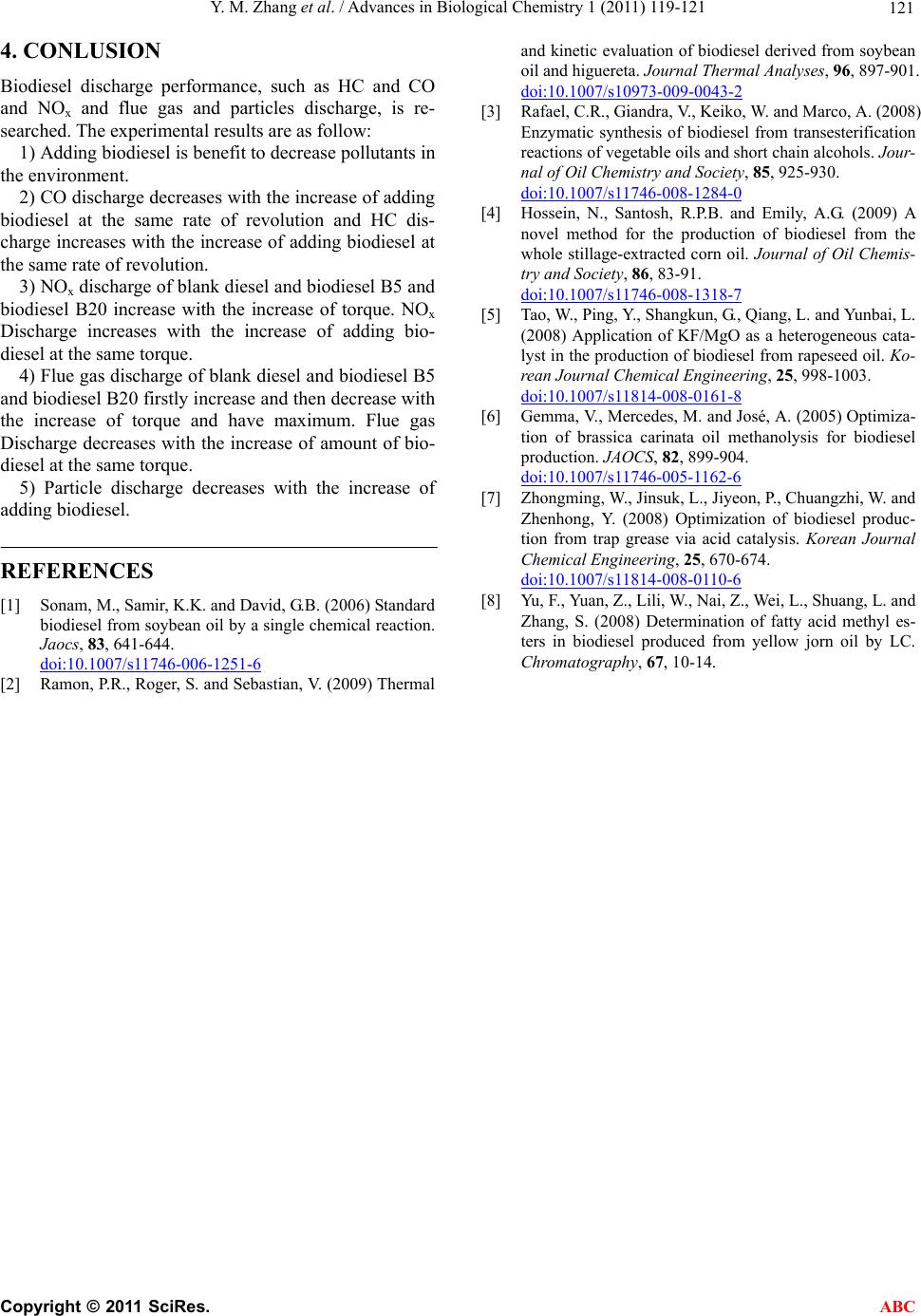
Y. M. Zhang et al. / Advances in Biological Chemistry 1 (2011) 119-121
Copyright © 2011 SciRes.
121
4. CONLUSION
Biodiesel discharge performance, such as HC and CO
and NOx and flue gas and particles discharge, is re-
searched. The experimental results are as follow:
ABC
1) Adding biodiesel is benefit to decrease pollutants in
the environment.
2) CO discharge decreases with the increase of adding
biodiesel at the same rate of revolution and HC dis-
charge increases with the increase of adding biodiesel at
the same rate of revolution.
3) NOx discharge of blank diesel and biodiesel B5 and
biodiesel B20 increase with the increase of torque. NOx
Discharge increases with the increase of adding bio-
diesel at the same torque.
4) Flue gas discharge of blank diesel and biodiesel B5
and biodiesel B20 firstly increase and then decrease with
the increase of torque and have maximum. Flue gas
Discharge decreases with the increase of amount of bio-
diesel at the same torque.
5) Particle discharge decreases with the increase of
adding biodiesel.
REFERENCES
[1] Sonam, M., Samir, K.K. and David, G.B. (2006) Standard
biodiesel from soybean oil by a single chemical reaction.
Jaocs, 83, 641-644.
doi:10.1007/s11746-006-1251-6
[2] Ramon, P.R., Roger, S. and Sebastian, V. (2009) Thermal
and kinetic evaluation of biodiesel derived from soybean
oil and higuereta. Journal Thermal Analyses, 96, 897-901.
doi:10.1007/s10973-009-0043-2
[3] Rafael, C.R., Giandra, V., Keiko, W. and Marco, A. (2008)
Enzymatic synthesis of biodiesel from transesterification
reactions of vegetable oils and short chain alcohols. Jour-
nal of Oil Chemistry and Society, 85, 925-930.
doi:10.1007/s11746-008-1284-0
[4] Hossein, N., Santosh, R.P.B. and Emily, A.G. (2009) A
novel method for the production of biodiesel from the
whole stillage-extracted corn oil. Journal of Oil Chemis-
try and Society, 86, 83-91.
doi:10.1007/s11746-008-1318-7
[5] Tao, W., Ping, Y., Shangkun, G., Qiang, L. and Yunbai, L.
(2008) Application of KF/MgO as a heterogeneous cata-
lyst in the production of biodiesel from rapeseed oil. Ko-
rean Journal Chemical Engineering, 25, 998-1003.
doi:10.1007/s11814-008-0161-8
[6] Gemma, V., Mercedes, M. and José, A. (2005) Optimiza-
tion of brassica carinata oil methanolysis for biodiesel
production. JAOCS, 82, 899-904.
doi:10.1007/s11746-005-1162-6
[7] Zhongming, W., Jinsuk, L., Jiyeon, P., Chuangzhi, W. and
Zhenhong, Y. (2008) Optimization of biodiesel produc-
tion from trap grease via acid catalysis. Korean Journal
Chemical Engineering, 25, 670-674.
doi:10.1007/s11814-008-0110-6
[8] Yu, F., Yuan, Z., Lili, W., Nai, Z., Wei, L., Shuang, L. and
Zhang, S. (2008) Determination of fatty acid methyl es-
ters in biodiesel produced from yellow jorn oil by LC.
Chromatography, 67, 10-14.